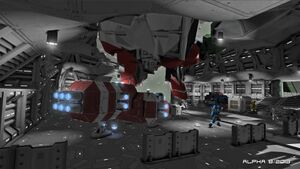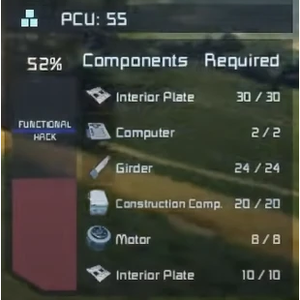Damage Mechanics
In Survival Mode, every block has hitpoints that represent its physical integrity, and players have hitpoints that represent their health.
In singleplayer, or if you are the server admin, you can enable or disable individual Damage Mechanics in the World Settings on a per game basis.
Damage levels
| Damage level | Players | Blocks |
|---|---|---|
| Full hitpoints | The players are healthy | A functional block is fully functional, an armor block is intact. |
| Loss of hitpoints | Collisions, explosions, exposure, or weapons have subtracted hitpoints and the players are wounded. They can still act normally. They can heal themselves using Life Support. | Collisions, explosions, or weapons have caused damage to blocks. Damaged above "the functional line", they still function. Blocks damaged below "the functional line" stop providing their functionality. Damaged armor blocks deform and allow damage to neighbouring blocks; dropped components turn into Scrap Metal. Damaged blocks can still be repaired. |
| Zero hitpoints | Dead players drop their backpack and respawn at an allied Medical Room or Survival kit. | If a block's hitpoints reach zero, the block breaks beyond repair. Its components turn into Scrap Metal. It stops providing its functionality; attached neighbouring blocks start coming loose. |
Voxel Damage
Voxels can be destroyed by explosions (such as warheads, rockets, and explosives), by meteors, by collisions or the impact of crashed ships, and by drills.
Tip: Depending on graphic settings, voxel changes on planet surfaces can be seen from orbit which can give away a player’s position in multiplayer.
To a certain degree you can “repair” smaller holes using Voxel Hands. But too much voxel deformation will eventually slow down performance. To really reset voxel deformations, use the Admin Screen.
Collision/Impact Damage
Collisions and impacts are equally devastating to ships, rovers, voxels, and player characters.
Examples of what counts as collision for ships and rovers (grids):
- Hitting voxels (mountains, asteroids, ice lakes, boulders) or grids when flying a ship or when catching air in a rover
- Free-falling from a height
- Being hit by flying block debris
- Intersecting with suddenly spawning loose Ores after a filled container bursts
When Hydrogen and Oxygen Tanks are damaged (or grinded) below the functional line, they leak fuel and eventually explode.
Examples for sources of collision damage for player characters:
- Hitting voxels (planet surface, boulders, ice lakes, asteroids) or grids when jetpacking
- Free-falling from a height with disabled jetpack
- Bumping into blocks or other players when not seated in a moving vehicle, e.g. due to abrupt rover/ship manoeuvres
- Being crushed by falling block debris, e.g. while salvaging wrecks in gravity
- Being hit by loose Ores, especially in tight mining tunnels
Colliding with trees and bushes doesn’t do much damage, but trees slow vehicles down and can make vehicles rebound into neighbouring voxels.
Grids made of only unfinished blocks will deal no impact damage, even though their mass is that of a fully built block.
Explosive Damage
Explosions affect grids, voxels, and player characters.
Short version: Don't store all ammo in one cargo container, distribute it using Sorters. Also, don't store oxygen and hydrogen tanks near essential parts of the ship.
- Any block that contains explosives or ammunition in its inventory will explode when destroyed by taking damage. The explosion radius is based on the amount and type of munitions that were inside the inventory.
- Destroyed Hydrogen and Oxygen Tanks explode and deal damage based on the amount of fuel left inside at the time of their destruction.
- Dropped Explosives detonated with weapon shots deal damage to blocks in a (1cm*number of explosives in stack) blast radius. Blocks get damaged proportionally to their distance to the explosion.
- Rockets have a 4m blast radius on impact, doing damage to blocks proportionally to their distance from the center of the blast.
- Warheads explode when shot (when armed), or after a countdown, or after manual detonation. Large-grid warheads have a 22.98m radius and small-grid warheads have 4.6m radius.
- Explosions affect blocks in a volumetric way, meaning blocks behind other blocks can remain unaffected if the blocks before it resist enough of the explosion's damage.
Penetration Damage
Only certain weapons have this kind of damage.
Penetration damage only penetrates blocks and characters. It is completely blocked by voxels and deals no damage to them.
The damage is consumed for every block it hits on its path until it can no longer destroy block (or character).
For example: a projectile with 6000 penetration damage comes across 3 large light armor blocks (2500hp each) along its path. It has enough damage to destroy the first two and now the projectile only has 1000 damage remaining which it deals to the 3rd armor block and stops.
Ricochet
Certain weapons support a ricochet system which has a chance for the projectile to bounce off blocks depending on the angle between the projectile's trajectory and the surface. The relation between chance and angle is linear but the numbers differ for each caliber.
Ricochets only work when hitting blocks.
Once the projectile does ricochet, it will deal a fixed amount of damage to the hit block and reduces the projectile's penetration damage by that same amount.
Projectile Weapon Damage
Block Weapons damage players and blocks, but not voxels. Artillery Shells and Assault Cannon Shells can ricochet against grids at certain angles.[1]
Credit goes to u/Whiplash141 for collecting this data! Whiplash's full spreadsheet contains many more details auch as damage per volume, per shot, per surface area, reload time, effective rate of fire, etc.
| Weapon name | Type | Grid Size | ~Size (m^3) | Damage type | Damage | DPS |
|---|---|---|---|---|---|---|
| Rocket Launcher | static | L | 31 | Explosion | 500 | 731 |
| Rocket Launcher | static | S | 0.5 | Explosion | 500 | 500 |
| Reloadable Rocket Launcher | static | S | 1 | Explosion | 500 | 500 |
| Gatling Gun | static | S | 0.5 | Impact | 90 | 1050 |
| Autocannon | static | S | 0.5 | Impact | 500 | 1250 |
| Assault Cannon | static | S | 1 | Penetration (or ricochet) | 4000 (2000) | 667 |
| Artillery | static | L | 62 | Penetration (or ricochet) | 17000 (7000) | 1417 |
| Railgun | static | L | 250 | Penetration | 50000 | 844 |
| Railgun | static | S | 2 | Penetration | 8000 | 400 |
| Interior Turret | automatic | L | 16 | Impact | 15 | 150 |
| Rocket Turret | automatic | L | 422 | Explosion | 500 | 409 |
| Rocket Turret | automatic | S | 16 | Explosion | 500 | 150 |
| Gatling Turret | automatic | L | 422 | Impact | 90 | 769 |
| Gatling Turret | automatic | S | 16 | Impact | 90 | 759 |
| Autocannon Turret | automatic | S | 12 | Impact | 500 | 1196 |
| Assault Cannon Turret | automatic | L | 280 | Penetration (or ricochet) | 4000 (2000) | 1263 |
| Assault Cannon Turret | automatic | S | 16 | Penetration (or ricochet) | 4000 (2000) | 667 |
| Artillery Turret | automatic | L | 422 | Penetration (or ricochet) | 17000 (7000) | 2667 |
Armor Durability
Welded and unwelded blocks have the same mass, welding them only adds durability in the form of hitpoints.
Each block's health, measured in Hitpoints, is equal to the sum of the health of its components, meaning that larger, more expensive, und undamaged blocks also have higher durability.
In short, the mass stays constant but hitpoints can decrease due to damage, and increase after repairs.
Blocks take bonus damage equal to the percentage missing from the built percentage. Example: a block built to 80% will take +20% more damage from all sources.
This bonus damage will not increase when you reduce the block's health percentage with damage.
| Name | Mass(kg) | Hitpoints | Hitpoints/Mass Ratio |
|---|---|---|---|
| Construction Component | 8 | 30 | 3.75 |
| Metal Grid | 6 | 15 | 2.5 |
| Interior Plate | 3 | 15 | 5 |
| Steel Plate | 20 | 100 | 5 |
| Girder | 6 | 15 | 2.5 |
| Small Steel Tube | 4 | 15 | 3.75 |
| Large Steel Tube | 25 | 60 | 2.4 |
| Motor | 24 | 40 | 0.6 |
| Display | 8 | 5 | 0.625 |
| Bulletproof Glass | 15 | 60 | 4 |
| Superconductor | 15 | 5 | 0.33 |
| Computer | 0.2 | 1 | 5 |
| Reactor Components | 25 | 20 | 0.8 |
| Thruster Components | 40 | 30 | 0.75 |
| Gravity Components | 800 | 500 | 0.625 |
| Medical Components | 150 | 70 | 0.4666 |
| Radio Communication Components | 8 | 15 | 0.5333 |
| Detector Components | 5 | 4 | 0.8 |
| Explosives | 2 | 5 | 2.5 |
| Solar Cell | 8 | 1 | 0.125 |
| Power Cell | 25 | 50 | 2 |
References
- Warfare 2 Weapon Balance -- Google Sheet by u/Whiplash141
- Mostly accurate-ish spreadsheet of the new weapon balance, by u/Whiplash141 (Reddit thread)
- ↑ Projectile Ricochet Feature Guide by Whiplash141


